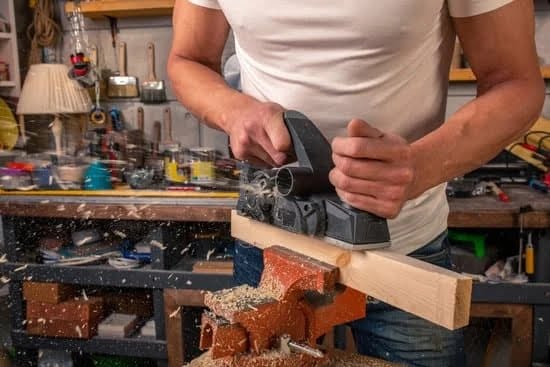Are you wondering what takes dried paint off woodwork? Dried paint on woodwork can be a pesky problem, making the surface look unsightly and potentially causing damage if not removed properly.
In this article, we will discuss the different types of dried paint found on woodwork, common mistakes in removal, and the tools and materials needed for effective removal. Whether it’s chemical paint removers or natural alternatives, we’ll explore various techniques for getting rid of dried paint from woodwork.
Dried paint on woodwork can be a challenging issue to tackle, as different types of paint may require different removal approaches. This is why it’s crucial to understand the various types of dried paint that can be found on woodwork and how each type requires a specific method for removal. Additionally, we will highlight the most common mistakes people make when attempting to remove dried paint from woodwork and the potential damage it can cause if not done properly.
In order to effectively remove dried paint from woodwork, it’s important to have the right tools and materials at your disposal. We will provide a comprehensive list of necessary items such as paint removers, scrapers, sandpaper, and protective gear. Additionally, we will explore the use of chemical paint removers and their effectiveness in removing dried paint from woodwork, as well as natural alternatives like vinegar, baking soda, and citrus-based solvents.
Understanding the Different Types of Dried Paint
When it comes to removing dried paint from woodwork, it is crucial to understand the different types of paint that can be found on surfaces. The two most common types are latex and oil-based paints. Latex paint is water-based and often used for interior applications, while oil-based paint is made with synthetic or natural resins and tends to have a more durable finish. Each type requires a different approach for removal.
Latex paint can often be removed from wood surfaces using a simple solution of warm, soapy water and a gentle scrubbing sponge. It is important to avoid using harsh abrasives or chemicals that could damage the wood underneath.
On the other hand, oil-based paint requires a bit more effort to remove, as it typically forms a tougher bond with the surface. In this case, using a paint stripper or mineral spirits may be necessary to effectively lift the dried paint from the woodwork.
| Type of Paint | Recommended Removal Method |
|---|---|
| Latex | Warm soapy water and gentle scrubbing |
| Oil-Based | Paint stripper or mineral spirits |
| Enamel | Abrasive removers such as sandpaper or scraping tools |
Common Mistakes in Removing Dried Paint
When it comes to removing dried paint from woodwork, it can be a daunting task that often leads to some common mistakes. Understanding these mistakes and the potential damage they can cause is crucial in order to effectively remove dried paint without causing harm to the woodwork.
Using Excessive Force
One of the most common mistakes people make when attempting to remove dried paint from woodwork is using excessive force. Whether it’s scraping with too much pressure or using abrasive materials, this can lead to scratches, gouges, and other damage to the wood surface. It’s important to approach the removal process with a gentle touch, allowing the proper tools and techniques to do the work without harming the underlying wood.
Not Testing Removal Methods
Another mistake is not testing removal methods on a small, inconspicuous area of the woodwork before applying them to a larger surface. Different types of paints and finishes may react differently to various removal methods, so it’s important to test a small area first to ensure that the chosen method will effectively remove the paint without damaging the wood underneath.
Not Wearing Protective Gear
Failure to wear proper protective gear is also a common mistake when removing dried paint from woodwork. Chemical paint removers and sanding processes can release harmful fumes and particles that can be harmful if inhaled or come into contact with skin or eyes. Wearing gloves, goggles, and a mask is essential for personal safety during the paint removal process.
Understanding these common mistakes and taking precautions against them is essential for safely and effectively removing dried paint from woodwork. By avoiding these pitfalls, individuals can successfully restore their wood surfaces without causing unnecessary damage or harm.
Tools and Materials Needed for Removal
When it comes to effectively removing dried paint from woodwork, having the right tools and materials is essential. The following is a comprehensive list of the necessary items needed for the removal process:
1. Paint removers: There are different types of paint removers available, including solvent-based, caustic-based, and biochemical options. It’s important to choose the appropriate paint remover based on the type of dried paint and the material of the woodwork.
2. Scrapers: A good-quality scraper is crucial for removing layers of dried paint from woodwork. Look for scrapers with sharp blades that can easily remove stubborn paint without damaging the wood surface.
3. Sandpaper: After using a paint remover and scraper, sandpaper is essential for achieving a smooth finish on the woodwork. Different grits of sandpaper may be needed depending on the level of paint removal required.
4. Protective gear: When working with chemical paint removers or sanding woodwork, it’s important to wear protective gear such as gloves, goggles, and a mask to protect yourself from harmful fumes and particles.
5. Drop cloths: To protect the surrounding area from paint splatters and debris during the removal process, use drop cloths or plastic sheeting to cover floors and furniture.
6. Heat gun (optional): In some cases, a heat gun may be useful for softening dried paint before using a scraper or sandpaper to remove it from woodwork.
7. Cleaners and solvents: Having cleaners such as mineral spirits or denatured alcohol on hand can help remove any residue left behind after scraping or sanding off dried paint.
By ensuring you have all these tools and materials ready before starting the removal process, you can effectively tackle dried paint on your woodwork without causing any unnecessary damage to your surfaces. Remember to always follow safety guidelines when working with chemical products and wear protective gear to prevent any accidents or injuries.
It’s important not to underestimate how critical having these tools are when it comes time for cleaning up after painting anything in your home or business – especially if you’re trying find out what takes dried paint off Woodwork.
So while daunting this step can be made more simple by getting all necessary equipment before rolling up sleeves.
Chemical Paint Removers
Safety Precautions
When using chemical paint removers, it is essential to work in a well-ventilated area to avoid inhaling harmful fumes. It is also advisable to wear protective gear, such as gloves, goggles, and a mask, to prevent skin contact and exposure to the eyes and respiratory system. Additionally, make sure to read and follow the instructions provided by the manufacturer of the chemical paint remover carefully.
Proper Application Techniques
Before applying the chemical paint remover, test it on a small, inconspicuous area of the woodwork to ensure compatibility and avoid any potential damage. Use a brush or roller to apply an even coat of the remover onto the dried paint, allowing it to sit for the recommended amount of time as per the product instructions.
Once the paint begins to lift or bubble, use a scraper or steel wool to gently remove it from the woodwork. Finally, thoroughly clean the surface with water and allow it to dry completely before proceeding with any refinishing steps.
Effectiveness
Chemical paint removers are highly effective in removing dried paint from woodwork, especially when dealing with multiple layers of stubborn or old paint. They can penetrate and lift the paint from intricate details and hard-to-reach areas on wood surfaces.
However, it is important to note that some chemical removers may contain harsh ingredients that can potentially damage certain types of wood or finishes if not used properly. Therefore, it is crucial to carefully follow all safety precautions and application techniques when using chemical paint removers.
Natural Alternatives for Paint Removal
When it comes to removing dried paint from woodwork, many people are concerned about using harsh chemical paint removers due to their strong odor and potential health hazards. Fortunately, there are natural and eco-friendly alternatives that can effectively remove dried paint without the use of harmful chemicals. By utilizing everyday household items such as vinegar, baking soda, and citrus-based solvents, you can safely and effectively remove dried paint from woodwork while minimizing the impact on the environment.
Vinegar: A Versatile Paint Remover
Vinegar is a versatile substance that can be used for a variety of household tasks, including removing dried paint from woodwork. Its acidic nature makes it an effective paint remover, especially for water-based paints. Simply soak a cloth in vinegar and apply it to the dried paint on the woodwork. Let it sit for a few minutes to soften the paint before using a scraper or brush to gently remove the softened paint.
Baking Soda: A Gentle Abrasive for Paint Removal
Baking soda is known for its gentle abrasive properties, making it an ideal natural alternative for removing dried paint from woodwork. Create a paste by mixing baking soda with water and apply it to the dried paint. Allow the paste to sit on the affected area for some time to help break down the paint. Then, gently scrub away the softened paint with a brush or cloth.
Citrus-Based Solvents: Effective and Environmentally Friendly
Citrus-based solvents are derived from natural ingredients found in citrus fruits and are known for their effectiveness in removing paints and varnishes. These solvents are biodegradable and non-toxic, making them an environmentally friendly option for removing dried paint from woodwork. Apply the citrus-based solvent to the affected area and let it sit for a few minutes before using a scraper or brush to remove the loosened paint.
By utilizing these natural alternatives for removing dried paint from woodwork, you can effectively restore your wood surfaces without exposing yourself or the environment to harsh chemicals. Whether you choose vinegar, baking soda, or citrus-based solvents, these natural options offer safe and eco-friendly solutions for tackling stubborn dried paint on woodwork.
Sanding and Refinishing Woodwork
After successfully removing dried paint from woodwork, it is essential to proceed with the process of sanding and refinishing to achieve a smooth and polished finish. This step is crucial in restoring the natural beauty of the wood while also ensuring that any remaining imperfections are addressed.
The first step in this process is to thoroughly clean the wood surface to remove any residue left behind by the paint removal process. This can be done using a damp cloth or mild cleaning solution, followed by drying the wood completely before proceeding with sanding.
Once the wood surface is clean, it is important to select the right type of sandpaper for the specific type of wood being refinished. Coarse-grit sandpaper can be used for initial sanding to remove any remaining paint or imperfections, while finer-grit sandpaper should be used for final smoothing and polishing. It’s important to always sand in the direction of the wood grain to avoid causing any damage or creating visible scratches on the surface.
After completing the sanding process, it is necessary to apply a new finish or coating to protect and enhance the appearance of the woodwork. This can include varnish, polyurethane, or even paint if desired. Once applied, it is important to allow sufficient time for drying before assessing if an additional coat is needed. Properly finishing off this step will leave your woodwork looking brand new.
| Step | Description |
|---|---|
| Clean Surface | Thoroughly clean wood surface after paint removal. |
| Select Sandpaper | Choose appropriate grit sandpaper – coarse for initial removal, fine for final smoothing. |
| Application of Finish | Apply varnish, polyurethane or other coatings after sanding. |
Maintenance Tips for Preventing Dried Paint
In conclusion, learning about the different types of dried paint and the most effective methods for removing it from woodwork is essential for maintaining the beauty and integrity of your wooden surfaces. Avoiding common mistakes in removal, using the right tools and materials, and considering both chemical paint removers and natural alternatives are all crucial steps in properly addressing dried paint on woodwork.
Furthermore, understanding the process of sanding and refinishing woodwork after the paint has been removed is important for achieving a polished finish.
Additionally, implementing maintenance tips to prevent dried paint from accumulating on woodwork in the future is equally important. This includes properly storing paint materials to avoid spillage or drying out, as well as regular cleaning and maintenance routines to keep woodwork looking its best. By following these guidelines, you can prolong the life of your wooden surfaces and ensure that they remain free from unsightly dried paint.
Frequently Asked Questions
How Do You Get Dried Paint Off Hard Wood?
Removing dried paint from hardwood can be a delicate process. One method is to gently scrape away the dry paint using a plastic putty knife, being careful not to scratch the wood.
Another option is to use a commercial paint remover specifically designed for wood surfaces, following the manufacturer’s instructions carefully. If the paint is stubborn, applying a small amount of mineral spirits on a soft cloth and rubbing the affected area may also help.
How Do You Remove Paint Without Damaging Wood Finish?
When it comes to removing paint without damaging the wood finish, it’s important to start with the least aggressive method first. One option is to use a mild solvent like denatured alcohol or mineral spirits on a soft cloth, applying gentle pressure to lift off the paint without harming the wood underneath.
For tough spots, you can try carefully scraping with a plastic putty knife or using fine steel wool in combination with the solvent.
Does Vinegar Remove Paint From Wood?
Vinegar has been known to be effective in removing some types of paint from wood surfaces. By soaking a rag in vinegar and laying it over the painted area for several hours (or even overnight), the acidity of the vinegar may soften and loosen the paint enough for it to be easily scraped or wiped away.
It’s important to keep in mind that while vinegar can work well for some types of paint, its effectiveness can vary depending on factors such as the type of paint and how long it has been set into the wood.

Hi everyone! I’m a woodworker and blogger, and this is my woodworking blog. In my blog, I share tips and tricks for woodworkers of all skill levels, as well as project ideas that you can try yourself.





